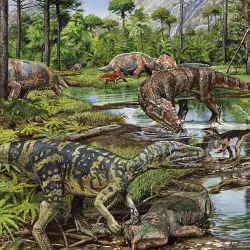
Triassic Period Timeline
Table of Contents
The Triassic Period is the first phase of the Mesozoic era and spanned for an interval of 35 million years from 250-205 million years ago. Planet Earth was a very different place back then with the most common difference being that all the continents were united to form one huge c shaped landmass or supercontinent known as Pangaea meaning “all lands”.
Two Extinctions & The Dinosaurs
This was an interesting time period because on the one hand a single continent allowed for the free movement of animal species from one region to another, hence diversification and change were common but on the other hand, it was also the time of the largest mass extinction ever to occur on the planet Earth.
This mass extinction also is known as the “Great Dying” accounted for the loss of over 95% of the then existing marine life as well as 70% of the terrestrial life. This wasn’t the extinction of a single species or a group of species but everything from plants, animals, insects, fishes, and pretty much most living things were totally wiped out. Some say that up to 99% of the living species of the world were gone in the blink of a prehistoric second.
Note that dinosaurs didn’t actually exist this early in the Triassic so this particular extinction is not to be confused with the second extinction which also occurred in the Triassic but towards its end. As far as dinosaur existence is concerned it was after the first mass extinction that both mammals and dinosaurs came into being but we’ll talk about that later.
The direct cause of the first extinction also known as the Permio-Triassic Extinction has baffled scientists for years and although there is very little evidence to pinpoint exactly how things ended there are a couple of theories which range from massive volcanic eruptions to a large asteroid hitting the planet or even a simple rise in temperatures due to the formation of the supercontinent. Any one of these events could have totally destroyed the Earth’s ability to support plant and animal life but we can never be sure.
Triassic Plant Life
The general weather and climate throughout the Triassic were very warm and arid. This was due to the lack of oceanic exposure and meant that the central region was primarily desert so plant life really only survived in the northern and southern hemispheres.
No flowering plants existed at this time so most plant life looked pretty boring as a mix of browns and greens. In general, the plant life of the Triassic consisted of cycads, lycophytes (mosses), Glossopterids (seed ferns), Ginkoes as well as other seed plants like conifers.
Triassic Animal Life
Coming into the Triassic the animal life consisted of species that had either survived the Permian-Triassic extinction or had newly appeared after the extinction. This factor alone made it a very interesting time period with many new appearances.
https://www.youtube.com/watch?v=YF11Ae4P4_Y
Insects and many other invertebrate species were extremely common and dominant in the Permian period, however, only a few of these made it into the Triassic. In fact, the Permian contained some of the largest insects ever recorded, sadly most of these did not survive into the Triassic, and instead, and a new form of modern insect evolved.
Other than that Ammonites, Corals, Amphibians, and various other specialized invertebrates survived and carried on throughout the Triassic. Reptiles were, for the most part, the most dominating species of the Triassic but despite this, the first mammals also appeared during this time period and were thought to have evolved from the mammal like reptiles (therapsids) that were common in the Permian period.
At this time the reptile scene was really starting to take over Dinosaurs (Land Reptiles), Pterosaurs(Flying Reptiles), Plesiosaurs (Marine Reptiles), Ichthyosaurus (Fish Reptiles) all started appearing. This was a great period for Archosaurs and the various other diapsid reptiles which were slowly taking over from the synapsids of the Permian period.
Other animals of note which also made a first appearance in the Triassic include turtles, frogs, crocodiles, and many types of lizards.
Despite the Triassic being the birth time of the dinosaurs they were still small and didn’t fully develop into the massive land reptiles we imagine them as until the Jurassic period. Some examples of the dinosaurs that made an appearance include:
- Coelophysis
- Eoraptor
- Plateosaurus
The Late Triassic Extinction
When the Triassic Period was about to end another mass extinction not quite as damaging as the first occurred. The worst damage was made to marine life where most marine reptiles except the plesiosaurs and the ichthyosaurs died out.
On the land, many of the large archosaur reptiles, labyrinthodont amphibians, Conodonts as well as some of the early dinosaur species all went extinct. This was a huge filtration process with many species completely eradicated from the planet. This however meant that the remaining dinosaurs were left as the largest land animals on the earth which set them up for complete domination into the Jurassic.
Just like most events this far back there is no clear answer as to what caused this extinction. Certainly, the supercontinent although still in one piece had started to split and huge volcanic eruptions have been recorded during this time period. Other theories include a meteor as well as planetary cooling. We really don’t know but what we do know is that whether out of pure luck or sheer genius the dinosaurs were automatically given a clear path to success after this major extinction process.
